J Dent Rehabil Appl Sci.
2020 Mar;36(1):55-60. 10.14368/jdras.2020.36.1.55.
Effect of quaternary ammonium compounds on microbial contamination levels in dental clinics
- Affiliations
-
- 1Department of Laboratory Medicine, Seoul Clinical Laboratories, Yongin, Republic of Korea
- 2Department of Orofacial Pain and Oral Medicine, Yonsei University College of Dentistry, Seoul, Republic of Korea
- 3Lami Dental Clinic, Seoul, Republic of Korea
- KMID: 2512125
- DOI: http://doi.org/10.14368/jdras.2020.36.1.55
Abstract
- The aim of this study was to investigate the change of microbial contamination levels in the different areas and at the different time points after application of a quaternary ammonium compound (QAC) that has mechanical antimicrobial effect. The microbial contamination levels were measured in three different areas; unit chair handle, spit sink area and hand piece holder at different time points using adenosine triphosphate (ATP) monitoring system and ATP surface test kit. Hand piece holder showed the highest level of microbial contamination. In most of the clinics, QAC significantly reduced the levels of microbial contamination, and maintained antimicrobial activity for 4 to 6 months. QAC may be used effectively in dental clinics due to the duration of antimicrobial effect and the minimal exposure of chemicals and further studies are needed with large sample size.
Keyword
Figure
Reference
-
1. Infection Control and Prevention in Healthcare Facilities. 2017. Korean Society for Healthcare-associated infection Control and Prevention. 5th ed. Hanmibook;Seoul: p. 497–513.2. Hoehl S, Berger A, Kortenbusch M, Cinatl J, Bojkova D, Rabenau H, Behrens P, Böddinghaus B, Götsch U, Naujoks F, Neumann P, Schork J, Tiarks-Jungk P, Walczok A, Eickmann M, Vehreschild M, Kann G, Wolf T, Gottschalk R, Ciesek S. 2020; Evidence of SARS-CoV-2 Infection in Returning Travelers from Wuhan, China. N Engl J Med. doi: 10.1056/NEJMc2001899. 2020 Feb 18. DOI: 10.1056/NEJMc2001899. PMID: 32069388.3. Elena P, Miri K. 2018; Formation of contact active antimicrobial surfaces by covalent grafting of quaternary ammonium compounds. Colloids Surf B Biointerfaces. 169:195–205. DOI: 10.1016/j.colsurfb.2018.04.065. PMID: 29778035.4. Cho JH. 2017; Updates on Antimicrobial coating agent. ISBC newsletter. 5:1.5. Lee JS, Jeong KH, Kim GH, Im IC, Kewon DC, Goo EH, Dong KR, Chung WK. 2011; Radiology Department Infection Control According to Radiography Frequency and Disinfection Period. J Korean Soc Radiol. 5:73–80. DOI: 10.7742/jksr.2011.5.2.073.6. Hygiena . 2016. SystemSURE Plus ATP Monitoring System Instruction Manual.7. Kampf G, Todt D, Pfaender S, Steinmann E. 2020; Persistence of coronaviruses on inanimate surfaces and their inactivation with biocidal agents. J Hosp Infect. 104:246–51. DOI: 10.1016/j.jhin.2020.01.022. PMID: 32035997.8. Saeb A, Mody L, Gibson K. 2017; How are nursing homes cleaned? Results of a survey of 6 nursing homes in Southeast Michigan. Am J Infect Control. 45:e119–22. DOI: 10.1016/j.ajic.2017.08.019. PMID: 28958448. PMCID: PMC5831402.9. Yun KO, Kim HY. 2015; A Study Regarding Bacterial Contamination of Surfaces in Dental Offices. Korean J Clin Lab Sci. 47:279–85. DOI: 10.15324/kjcls.2015.47.4.279.10. Jagrosse D, Bommarito M, Stahl JB. 2012; Monitoring the Cleaning of Surgical Instruments with an ATP Detection System. Am J Infection Control. 40:e90–1. DOI: 10.1016/j.ajic.2012.04.159.11. Lewis T, Griffith C, Gallo M, Weinbren M. 2008; A modified ATP benchmark for evaluating the cleaning of some hospital environmental surfaces. J Hosp Infect. 69:156–63. DOI: 10.1016/j.jhin.2008.03.013. PMID: 18468725.12. Wang H, Ren D. 2017; Controlling Streptococcus mutans and Staphylococcus aureus biofilms with direct current and chlorhexidine. AMB Express. 7:204. DOI: 10.1186/s13568-017-0505-z. PMID: 29143221. PMCID: PMC5688048.13. Lee SG, Kang BR, Kim HS, Park HH, Park HR, Yoon SK, Nam SH. 2017; Changes in the number of bacteria in a toothbrush according to the toothbrush management method. Biomed Res. 28:7306–7310.
- Full Text Links
- Actions
-
Cited
- CITED
-
- Close
- Share
- Similar articles
-
- Mechanism of the Positive Inotropic Actions of Quaternary Ammonium Compounds
- Is Otilonium Bromide Really Effective for Treating Asian Patients With Irritable Bowel Syndrome?
- Is Otilonium Bromide Really Effective for Treating Asian Patients With Irritable Bowel Syndrome?: Author's Reply
- The Effect of a Small dose of Glycopyrrolate and Propantheline on the Heart Rate
- Simple Method of Preparation and Characterization of New Antifungal Active Biginelli Type Heterocyclic Compounds




